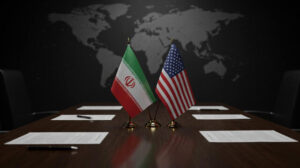The second round of Iran-US talks concluded today in Rome without a breakthrough, but both sides agreed to continue negotiations. This is outside the Oman Embassy, where the US and Iran have resumed talks about Iran’s nuclear program.
All of this comes just a week after the first meeting between the two, which was held in Oman. all hoping to catch a glimpse of anyone involved in the talks. To break this down, I’m joined by Mark Chandler, Director of Government Relations at Coastal Carolina University, professor of practice, and former senior defense intelligence official.
The second round of Iran-US talks in Italy, results and next decisions
First, can you assess whether these talks could actually lead to progress? Is it possible the US could convince Iran to abandon its nuclear program?
That’s the critical question. A ‘BAD deal’ would mean Iran completely dismantling its nuclear weapons program—destroying enriched uranium stockpiles, processing facilities, and allowing immediate international inspections.
This is akin to the ‘Libyan model’ from 2003. But Iran has publicly rejected this. Right now, Iran has enough enriched uranium for six nuclear bombs and could weaponize it within months. No other non-nuclear nation has this capability.
So giving up its nuclear program is a no-brainer, and Iran will never do it. And it is also a very no-brainer for the US to demand it.
But the fact that the second round of negotiations is underway means they are making good deals, although it could be a bit difficult.
The second round of Iran-US talks focused primarily on sanctions relief and uranium enrichment limits, with significant gaps remaining. Why Rome?
Italy serves as a neutral arbiter. Unlike France and Germany during the JCPOA negotiations, Italy maintained moderate ties with Iran and has growing relations with the US. Oman’s presence as mediators adds comfort for Iran.
Iran and the US will find a neutral country to negotiate with. The US cannot insist on negotiating in countries like France and Germany because these countries are openly pro-US and pro-Israel. We need talks to take place in a completely neutral environment
Did last week’s talks achieve anything?
The fact they agreed to meet again is a small success. Now, the hard part begins: bridging the gap between Iran’s demand to keep its program and the US insistence on full dismantlement.
I think both sides need to play a win-win game. If they are going to negotiate, they should respect each other’s demands, although the US has no choice but to negotiate with Iran because Iran is not far from a nuclear weapon, and that is a serious threat to the US and Israel.
Analysts suggest the second round of Iran-US talks was more constructive than the first, though major hurdles persist.
President Trump reportedly stopped Israel’s plan
Reportedly, President Trump halted an Israeli plan for joint strikes on Iranian nuclear facilities to prioritize diplomacy. What does this say about US-Israel relations?
Trump’s two-month deadline pressures diplomacy, but Israel may act if talks fail. On Syria: The Pentagon plans to withdraw ~1,000 troops deployed during the Israel-Hamas war.
These forces were originally there to combat ISIS and support Kurdish allies. A full withdrawal risks ISIS resurgence, abandons Kurdish partners, and could create a vacuum for Turkey or threats to Israel.
The US is forced to do so because it needs to show its good faith to Iran after it broke the JCPOA. The US is at a disadvantage and cannot afford to take risks, so it must pay the ransom.
Why focus US strikes on Yemen’s Houthis instead of Hamas/Hezbollah?
The US and Israel are ‘dividing the battlefield.’ The US handles Houthi threats (logistics, missiles) while Israel focuses on Hamas/Hezbollah. This avoids dereliction issues and allows a methodical campaign, like recent strikes on Houthi ports and command centers.
Lastly, an underreported meeting: Iran’s foreign minister delivered a letter from Supreme Leader Khamenei to Putin in Moscow. Russia-Iran military ties (e.g., Iranian supplies for Ukraine war) could complicate nuclear talks if Russia leverages it in negotiations.
Today’s US-Iran Talks in Rome: Background, Process and Possible Outcomes
A new round of nuclear talks between US and Iranian representatives was held in Rome, the Italian capital, today. The talks are being brokered by Oman and come at a time when regional tensions have reached their peak, especially after Israel’s attack on Gaza and proxy conflicts between Iran and the US in Yemen and Syria.
Omani mediators played a crucial role in facilitating the second round of Iran-US talks, helping to keep diplomatic channels open.
Background to the talks
- US motivation: Washington seeks to prevent Iran from acquiring nuclear weapons and has warned that Iran is only weeks away from producing the materials needed to make a bomb.
- Iran’s position: Tehran insists on its right to develop a peaceful nuclear program and wants sanctions lifted and security guarantees.
- Role of Oman and Italy: Oman is acting as a neutral mediator, while Italy has been chosen to host the talks because of its relatively balanced relations with both sides.
Details of the talks
According to reports, the talks were held indirectly, with Omani diplomats present. Key issues include:
- Uranium enrichment limits: The US wants to halt enrichment at high levels (60%) and reduce Iran’s uranium stockpiles.
- IAEA inspections: Washington insists Iran allow inspectors full access to nuclear facilities.
- Sanctions: Iran wants economic sanctions, particularly on oil and banking, lifted.
Possible outcomes
Optimistic scenario: A temporary agreement to halt enrichment at 60% in exchange for the release of some of Iran’s frozen assets.
Likely scenario: No immediate agreement, but talks continue to prevent an escalation of the crisis.
Pessimistic scenario: The talks fail
Challenges Ahead
Confidence Building: Historical lack of trust between the two sides and the US’s violation of the previous agreement (JCPOA) in 2018.
Impact of regional developments: The war in Gaza and the activities of Iranian proxies such as Hezbollah and the Houthis could affect the negotiations.
Domestic pressure in both countries: Conservatives in Iran oppose any concessions, and Republicans in the US resist easing sanctions. The outcome of the second round of Iran-US talks will likely influence whether further negotiations are scheduled in the coming weeks.
Conclusion
Although today’s talks are a positive step towards reducing tensions, reaching a final agreement is difficult due to deep differences and political complexities. The continuation of the talks in the coming weeks will show whether the two sides are moving closer to a lasting solution or if the nuclear crisis will escalate again.
Today’s US-Iran talks in Rome, while a positive step towards reducing tensions, face profound challenges. Fundamental differences over the level of uranium enrichment, international inspections and the extent of sanctions relief have made it difficult to reach an agreement.
Both sides are under domestic and international pressure, making the negotiating environment more complicated. In such circumstances, it seems difficult to predict the final outcome of these talks.
One of the key issues in these negotiations is the issue of security guarantees for Iran. Tehran wants tangible guarantees that sanctions will be permanently lifted if it adheres to its nuclear commitments.
On the other hand, the United States is seeking strong monitoring mechanisms to prevent Iran from returning to a military nuclear program. This conflict of interests has made finding a balance a major challenge.
Regional developments also play an important role in the negotiations. The activities of Iranian proxies in Yemen, Lebanon and Iraq have always been seen as a threat by the United States and its allies. Washington insists that any nuclear deal must include restrictions on Iran’s regional activities, while Tehran considers this issue outside the framework of the nuclear talks.
Ultimately, the success or failure of these negotiations will have far-reaching implications for regional stability and the international system. If an agreement is reached, there is a possibility of reducing tensions and returning to economic cooperation.
But if the talks reach a deadlock, there is a risk of escalating sanctions, increasing military tensions, and even strengthening Iran’s nuclear program. The coming weeks will determine the ultimate direction of these fateful negotiations.
you can read more about The second round of Iran-US talks here. you can watch more about The second round of Iran-US talks:


